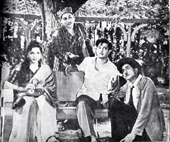 |
| A still from Missiamma |
Seventy-seven years after his death, family members of Rabindranath Maitra, who wrote the play Manmoyee Girls’ School, are organising an event in his memory.
The side-splitting comedy, which has been performed countlessly and filmed a number of times, was first staged at Star Theatre by Art Theatre on December 20, 1932. It catapulted Maitra to overnight fame.
The story of Manas and Niharika, one a Christian and the other a Hindu, pretending to be married only to keep their jobs in a girl’s school, was quickly picked up by director Jyotish Banerjee for a film with Jahar Ganguly and Kanan Devi in the lead.
It was remade in 1958 by director Hemchandra with Uttam Kumar and Arundhuti Devi. The film’s popularity led to the production of Missiamma in (Telugu) featuring NTR, and Miss Amma (Tamil) featuring Gemini Ganesan.
The popularity of Manmoyee, which promises to remain in fashion as long as people want to hold on to their jobs, has completely overshadowed Maitra’s other works: Porajoy, Niranjan, Third Class, Mayabanshi and Udashir Matt.
Manmoyee was first published in Shanibarer Chithi, a journal that looked at contemporary life with sharp satire. Maitra had been editor of Shanibarer Chithi at one point in which he wrote under the pseudonym Dibakar Sharma. He also wrote for Prabashi and the ‘Dadhikardam’ column of Anandabazar Patrika. He had a deep sense of social responsibility and worked for the development of the Santhal and Oraon communities.
His was a brief, brilliant career. He didn’t live to see how popular Manmoyee would become, succumbing to malignant malaria in 1933, when he was only 36.
The Rabindranath Maitra Smritiraksha Committee is hosting the smaran sabha on July 24, 5.30pm, at the Jogesh Mime Academy.
 |
| Jogen Chowdhury at a workshop organised by the income tax department. (Sanat Kumar Sinha) |
Of art and taxes
While many may be confused by the relation of art and taxes, there is no such doubt in the mind of commissioner Income Tax (II), Bratati Mukherjee. She was one of the organisers of Building the Nation through Income Tax, an art and sculpture workshop organised on July 12 and 13, to celebrate 150 years of the income tax department.
“Till this year we had organised a lecture or had a written presentation. But art is a very strong medium. Everyone knows that Picasso’s Guernica is the strongest representation of the horrors of war. So this year we wanted to do something with art,” she explains.
The system of collecting income tax was introduced in Calcutta (then capital of British India) in 1860 by James Wilson, who was the first financial member of the viceroy’s council. Incidentally, Wilson died the same year and his last words were supposedly, “Take care of my income tax.”
Thus orphaned, the new-born income tax department in the country managed to survive and flourish. After Independence, the character and work of the department changed.
“Before Independence, the tax used to be spent mostly for maintenance of law and order. After Independence, the money is being used for social development,” says Mukherjee.
This was the message that the department wanted to convey through the workshop. One artist has painted a beehive to show how the contribution of each goes on to build the society. Another has drawn a Lakshmir jhaanpi.
The workshop was attended by over 30 artists, including Jogen Chowdhury, Ganesh Haloi, Prokash Karmakar, Partha Pratim Deb, Dipali Bhattacharjee, Anita Roy Choudhury, Shyamshree Basu and Wasim Kapoor. The works were exhibited at the Town Hall.
 |
 |
| Debjani Mukerjee (below) and her animation on the Mohiner Ghoraguli song Sattala Bari |
Sand pictures
The lines of a woman’s long hair growing into waves, breaking up into a grainy sea shore. A little girl finds a shell — the sound of the shell flows out taking the child back to the sound of her mother’s heartbeat heard in childhood. And so the visual narrative moves backwards and forwards like the tide, shifting sand and forming newer images.
Welcome to sand animation, an experimental medium used for the music video of Sabdhane Rasta Periyo from the upcoming Cactus album Tuchchho. The visual has been created by National Institute of Design diploma holder Debjani Mukherjee.
Sand is a comparatively new medium in animation in this part of the world. It is done by manipulating a layer of sand on a glass table lit from below. The areas covered with a thicker layer of sand appear darker than the ones with less sand. The drawings of 24 frames for a second are recorded by a digital camera mounted over the glass table.
“Sand expresses the fluidity of thoughts. I like it because like life you have to flow with it,” says Debjani.
Her other works include the film Chai Break and The Seven Storied House on a Mohiner Ghoraguli song Sattala Bari.
There are few institutes offering comprehensive training, rues Debjani. “Youngsters mostly try to learn ‘on the job’ by joining outsourcing companies where layouts are usually provided by foreign designers and the scope for experimentation and individualism is limited.”
 |
| An inter-school football match |
World Cup geography
Now that the World Cup is over, lessons have been learnt.
It has led to greater command of geography among the young ones. Ten-year-old Amartya Bannerji, a student of Garden High School, knows the Brazilian flag by heart, right down to the small white stars and what is written on it.
At Alipore Tiny Tots Private Nursery School, the students of classes three and four recently played a football match as teams Brazil and Spain. Shayan Mukherjee, a class four student, recalls how the students made better use of their atlases in the preceding days, looking up countries and capitals. “We would try to see who could find out about a country first and discuss the individual flags after that,” says Shayan.










